文章信息
- 朱盼, 应介官, 彭抒昂, 姜存仓
- ZHU Pan, YING Jie-guan, PENG Shu-ang, JIANG Cun-cang
- 生物炭和石灰对红壤理化性质及烟草苗期生长影响的差异
- Effects of Biochar and Lime on Soil Physicochemical Properties and Tobacco Seedling Growth in Red Soil
- 农业资源与环境学报, 2015, 32(6): 590-595
- Journal of Agricultural Resources and Environment, 2015, 32(6): 590-595
- http://dx.doi.org/10.13254/j.jare.2015.0152
-
文章历史
- 收稿日期: 2015-06-19
2. 农业部长江中下游耕地保育重点实验室, 湖北 武汉 430070;
3. 华中农业大学园艺与林学学院, 湖北 武汉 430070
2. Key Laboratory of Arable Land Conservation, Ministry of Agriculture, Wuhan 430070, China;
3. College of Horticulture and Forestry Sciences, Huazhong Agricultural University, Wuhan 430070, China
烟草是我国云南、湖南、江西等红壤区的一种重要经济作物。但在湿热条件下发育而成的红壤,pH值低、铝氧化物富集、矿质养分和有机碳含量低,因而肥力贫瘠,不利于作物生长。传统的石灰改良法能够提高土壤pH值、消除对作物有害的铝离子,以及提供作物生长必需的钙离子。因此,合理施用石灰可以促进作物根系生长[1],对增加作物产量具有一定的效果[2]。但长期或过量施用石灰也可能会使土壤板结,造成土壤中钙、镁、钾等元素失调而导致作物减产[3]。
生物炭是由木材、作物秸秆和动物残体等生物质在缺氧条件下产生[4]。其含碳量可达40%~75%[5],具有稳定的芳香结构,可在土壤中形成稳定的有机质碳库[6],长久以后能够成为土壤有机碳的一部分[7]。施用生物炭也有利于提高土壤K、P、Ca和Mg等矿质养分的含量[8]。张祥等[9]在红壤中施用生物炭使土壤N、P和K等养分的速效态含量显著提升。Major等[10]也发现,施用生物炭的土壤中有效态Ca和Mg含量明显增加。由于生物炭中的碳酸盐[11]以及-COO-和-O-等有机官能团都能与土壤中H+相互作用[12],因此,它能够提高土壤pH值和降低交换性铝含量。另外,生物炭对促进作物生长效果良好[13, 14]。生物炭对黑麦草[15]、小麦和萝卜[11]等作物产量均有明显的提高效果。目前,有关生物炭对红壤上烟草生长的研究相对较少,本试验通过对比生物炭与石灰对烟草生长及红壤理化性质影响的差异,探讨生物炭改良土壤的机制,为其应用提供理论依据。
1 材料与方法 1.1 试验材料供试红壤取自江西省,其理化性质为:pH 4.55,速效钾26.6 mg·kg-1,速效磷0.8 mg·kg-1,碱解氮20.1 mg·kg-1和有机碳含量3.4 g·kg-1,交换性钙(Exc-Ca)50.0 mg·kg-1,交换性镁(Exc-Mg)10.1 mg·kg-1,交换性铝(Exc-Al)453.2 mg·kg-1,交换性锰(Exc-Mn)0.65 mg·kg-1。烟草种子由华中农业大学园林学院提供。
在400 ℃条件下以花生壳制备的生物炭,其性质:pH 8.49,氮(N)18.8 g·kg-1,磷(P)2.5 g·kg-1,钾(K)8.5 g·kg-1,钙(Ca)2.2 g·kg-1,镁(Mg)1.1 g·kg-1,锰(Mn)6.7 mg·kg-1,全炭(TC)400.9 g·kg-1。
1.2 试验设计盆栽试验在华中农业大学大棚内进行,设置了4个生物炭用量(0、0.5%、1%、2%)和1个适宜的石灰用量(氯化钙交换法测定:0.3%),共5个处理:CK(0)、C0.5(0.5%)、C1(1%)、C2(2%)和S(0.3%石灰),每个处理重复4次,共20盆。每盆1.5 kg土壤,底肥施用0.21 g KH2PO4,0.15 g KNO3,0.35 g Ca(NO3)2,0.37 g MgSO4·7H2O,与土壤混匀。2014年6月13日每盆中播种20粒烟草种子,发芽后进行培养并间苗,25 d后每盆保留1株生长状况良好的幼苗,然后再培养50 d收获。
1.3 样品测定收获时,测定烟株农艺性状、生物量(鲜重),然后采集、处理和保存植物样品以及土壤(收获烟苗后)样品。土壤样品测定:水土比2.5∶1测定pH值;重铬酸钾容量法测定有机碳(SOC);碱解扩散法测定碱解氮(SAN);钼锑抗比色法测定速效磷(SAP);火焰光度法测定速效钾(SAK);铝试剂比色法测定交换性铝(Exc-Al);原子吸收分光光度法测定交换性钙、交换性镁、交换性锰(Exc-Ca,Exc-Mg,Exc-Mn)。植物样品(全部叶片)测定:凯氏定氮法测定氮(N);钼锑抗比色法测定磷(P);火焰光度法测定钾(K);原子吸收分光光度法测定钙镁(Ca,Mg)。
1.4 数据分析采用Excel 2010进行数据整理,SPSS 20进行单因素方差分析,不同处理之间多重比较采用 Duncan 新复极差方法,然后经过t检验(P<0.05)。
2 结果与分析 2.1 不同处理对烟草生物量和农艺性状的影响由图 1可知,对照处理的红壤中烟苗生物量生长受到抑制。施用生物炭或石灰后,烟苗的生长状况得到明显改善,生物量大幅度提升。烟苗的生物量随着生物炭用量的增加而增加,而石灰(S)处理中烟苗的生物量介于C1处理和C2处理之间。
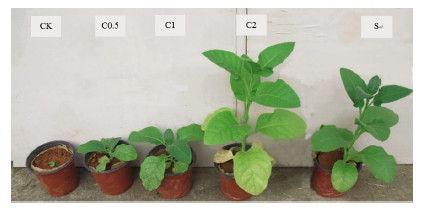
|
| 图 1 不同处理对烟草苗期生长的影响 Figure 1 Effects of different treatments on growth of tobacco seedlings |
施用生物炭和石灰后,烟苗的株高、茎粗、最大节距、最大叶面积和叶片数目等农艺性状得到明显改善(表 1)。与对照处理相比,烟苗的根冠比随着生物炭用量的增加呈现出先增大后减少的趋势。其中,C0.5处理中烟苗的根冠比对照增加了55.6%,而C2处理中烟苗的根冠比与S处理相同。
 |
生物炭和石灰对烟苗叶片中N、P、K、Ca和Mg等矿质元素的含量具有较大影响(表 2)。与对照处理相比,石灰处理中烟叶的N、P和Ca含量分别提高了16.7%、9.3%和297.5%,但K和Mg含量分别减少了19.0%和13.3%。施入生物炭,C0.5和C1处理中烟叶的N、P、K、Ca和Mg含量比CK处理均有显著提升。其中C1处理中烟叶K和Mg含量的提升幅度分别可达94.8%,76.7%;C2处理中烟叶的K、Ca和Mg含量也有所提高,但N和P含量出现下降,其中N含量的下降幅度可达9.3%。
 |
施入生物炭或石灰后,红壤的pH值比对照处理显著提高(图 2)。石灰处理中pH值比CK处理提升了1.10个单位。不同用量的生物炭C0.5、C1和C2土壤的pH值分别比CK处理增加了0.29、0.51和0.98个单位。
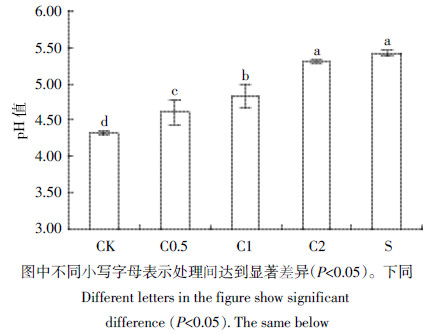
|
| 图 2 不同处理对土壤pH 值的影响 Figure 2 Effects of different treatments on soil pH |
生物炭与石灰对红壤有机碳的影响不同(图 3)。施石灰后,土壤有机碳含量变化不明显。施用生物炭,红壤的有机碳含量显著提高,且随用量越高效果越明显。其中,C0.5、C1和C2处理红壤的有机碳含量分别比CK处理提高了65.1%、165.1%和355.8%。
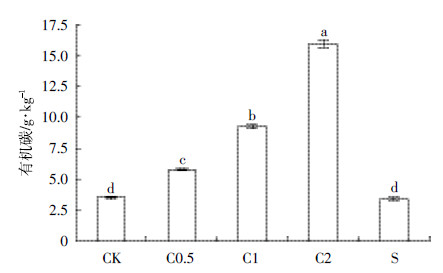
|
| 图 3 不同处理对土壤有机碳的影响 Figure 3 Effects of different treatments on soil organic carbon |
施用生物炭或石灰对红壤养分含量具有很大的影响(表 3)。与对照处理相比,石灰处理的土壤交换性钙含量大幅增加,碱解氮、速效钾和交换性镁含量则分别下降18.1%、48.6%和15.4%。表 3显示,生物炭施用量越多,土壤矿质养分的提升效果越明显。其中,C2处理中碱解氮、速效磷、交换性钙和交换性镁含量分别比CK处理提高了8.8%、44.3%、553.3%和277.3%。
生物炭和石灰对红壤交换性铝有相似的影响(图 4)。施用石灰后,红壤中的交换性铝含量大幅度下降,其降幅可达66.5%。施用少量生物炭(C0.5处理)便能够有效地降低红壤的交换性铝含量,且生物炭用量越多效果越明显。其中,C2处理和S处理对降低红壤交换性铝含量的效果接近。图 5表明,生物炭和石灰对红壤交换性锰含量的影响不同。施用石灰可降低土壤的交换性锰含量和土壤交换性铝含量。然而,施用生物炭会导致红壤的交换性锰含量增加。其中,C0.5、C1和C2处理土壤交换性锰含量分别比CK增加了42.0%、231.9%和323.2%。因此,在施用生物炭时需要注意红壤出现“锰毒”危害。
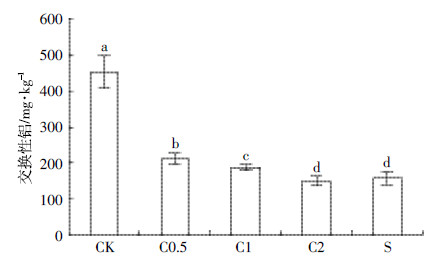
|
| 图 4 不同处理对土壤交换性铝含量的影响 Figure 4 Effects of different treatments on soil exchangeable aluminum |
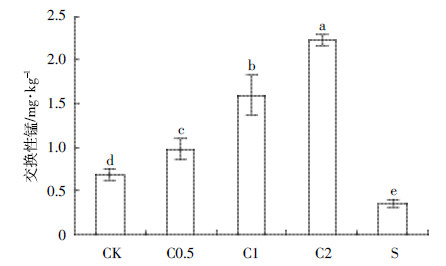
|
| 图 5 不同处理对土壤交换性锰含量的影响 Figure 5 Effects of different treatments on soil exchangeable manganese |
本试验中,对照处理中烟苗的生长受到抑制;而施用石灰和生物炭后,烟苗的生长较好,生物量增加。尹永强等[3]认为,酸性土壤抑制烟草生长的主要原因是酸度大损害了烟草根系生长,进而影响养分吸收。因此,本试验中生物炭和石灰处理中烟苗的根冠比增大,可能与它们能够改善烟苗根系生长有关。本试验与前人的研究结果类似,即增施生物炭能够显著提高作物的地上部生物量及产量[16],作物产量的增幅可达20%~200%[17]。这说明施用生物炭或石灰均可促进作物生长和提高作物产量[1, 18, 19]。
试验结果表明,生物炭和石灰对烟叶养分含量的影响有所差别。与对照处理相比,石灰处理中烟叶的N、P和Ca含量升高,而K和Mg含量下降。其原因可能是盆栽试验土壤容积有限,养分供给不足(尤其是K和Mg)。Major等[20]报道称,施用生物炭提高了玉米旗叶中Ca和Mg含量。本试验在红壤中施入生物炭,烟叶的K、Ca和Mg含量高于对照处理,且较低用量的生物炭处理(即C0.5和C1处理)中烟叶的N和P含量也高于对照处理。其原因是生物炭含有丰富的N、P、K、Ca和Mg等矿质养分,能够提高红壤的养分水平[8]。此外,有研究发现,生物炭施用过多会导致土壤C/N增加[21],降低氮素的有效性,从而抑制作物对氮素的吸收。本试验结果与其类似,施用2%生物炭时烟叶的N含量降低了9.3%。以上结果说明,施用生物炭和石灰均能够促进烟苗对养分的吸收,但其作用效果与土壤的养分含量有关。
3.2 生物炭和石灰对红壤矿质养分的影响土壤有效养分和有机碳含量是土壤的重要组成部分,与土壤肥力密切相关。传统的石灰改良法可以增加土壤交换性钙离子浓度,还能够加速有机质的分解和还原性氮的释放[18]。Caires等[1]曾报道,施用石灰提高了0~5 cm土层的交换性钙含量。本试验施用石灰后,红壤的交换性钙含量增加,有机碳含量没有明显变化。这说明施用石灰可以补充土壤Ca元素,但在短期内(约3个月)对土壤有机碳没有影响。烟苗收获后,石灰处理中碱解氮和速效钾含量较对照处理下降,其原因可能是盆栽土壤的养分总量有限。研究表明添加生物炭能够增加土壤的有效K、P、Ca和Mg[22]和有机碳[6]含量。本试验结果与其一致,生物炭处理中土壤的速效磷、速效钾、交换性钙、交换性镁和有机碳含量均明显高于对照处理。而当施用2%生物炭时,烟苗生长速度快,盆栽土壤的养分供给不足,从而导致该处理速效钾含量低于对照处理。此外,本试验还发现施用生物炭可提升土壤碱解氮的含量。这与前人结果有所不同[23],这可能与生物炭的原料、组分的差异有关。上述结果说明,可以通过施用生物炭提高土壤的多种矿质养分[24]和有机碳[25]含量。
3.3 生物炭和石灰对红壤pH值、交换性铝和交换性锰的影响烟草最适合生长的pH值在5.5~6.5,土壤pH值过高或过低都不利于烟叶生长,进而影响植株成熟后的烟叶品质。以往主要通过施用石灰提高土壤的pH值、减少其交换性铝[26, 27]。此外,施用石灰还能够有效减轻土壤锰毒危害[19]。本试验结果与其一致,即石灰处理中红壤的pH值显著提升,交换性铝和交换性锰含量明显下降。据报道称,生物炭灰分中的盐基离子(K+、Ca2+和Mg2+等)、有机官能团[12]可以交换或吸附土壤中的酸性离子[11, 28, 17],因此施用生物炭也能够改变土壤的酸碱度。本试验中,施入生物炭使红壤的pH值显著提升,交换性铝含量明显降低。本研究还显示施用生物炭会导致红壤交换性锰含量的增加。谢忠雷等[29]在锰形态的研究中发现土壤的交换态锰含量随pH值、CEC和有机碳含量提高而增加。因此,施用石灰或生物炭后,土壤pH值、有机碳含量的变化可能导致了红壤交换性铝含量的改变,但其具体影响机制还需进一步探究。
4 结论施用石灰或生物炭可以有效降低红壤的酸度和交换性铝含量,促进烟苗对多种矿质养分的吸收,以及改善烟苗生长状况。同时,施用生物炭可以提升红壤中N、P、K、Ca、Mg等多种矿质养分和有机碳含量。然而,与石灰处理不同,生物炭用量过多可能会抑制烟苗对氮素的吸收。此外,添加生物炭会导致红壤中交换性锰含量的增加,但是生物炭对其影响机制尚不明确。
| [1] | Caires E F, Garbuio F J, Churka S, et al. Effects of soil acidity amelioration by surface liming on no-till corn, soybean, and wheat root growth and yield[J]. European Journal of Agronomy, 2008, 28(1): 57-64. |
| [2] | Prado R D, Natale W. Effect of liming on the mineral nutrition and yield of growing guava trees in a typic hapludox soil[J]. Communications in Soil Science and Plant Analysis, 2008, 39(13-14): 2191-2204. |
| [3] | 尹永强, 何明雄, 邓明军. 土壤酸化对土壤养分及烟叶品质的影响及改良措施[J]. 中国烟草科学, 2008, 29(1): 51-54. YIN Yong-qiang, HE Ming-xiong, DENG Ming-jun. Effects of soil acidification on soil nutrients and quality of flue-cured tobacco and its countermeasures[J]. Chinese Tobacco Science, 2008, 29(1): 51-54. (in Chinese) |
| [4] | Lehmann J, Gaunt J, Rondon M. Bio-char sequestration in terrestrial e-cosystems: A review[J]. Mitigation and Adaptation Strategies for Global Change, 2006, 11: 395-419. |
| [5] | 何绪生, 张树清, 佘 雕, 等. 生物炭对土壤肥料的作用及未来研究[J]. 中国农学通报, 2011, 27(15): 16-25. HE Xu-sheng, ZHANG Shu-qing, SHE Diao, et al. Effects of biochar on soil and fertilizer and future research[J]. Chinese Agricultural Science Bulletin, 2011, 27(15): 16-25. (in Chinese) |
| [6] | 勾芒芒, 屈忠义. 生物炭对改善土壤理化性质及作物产量影响的研究进展[J]. 中国土壤与肥料, 2013(5): 1-5. GOU Mang-mang, QU Zhong-yi. Research on using biochar to agricultural soil amendment and crop yield[J]. Soil and Fertilizer Sciences in China, 2013(5): 1-5. (in Chinese) |
| [7] | 陈温福, 张伟明, 孟 军, 等. 生物炭应用技术研究[J]. 中国工程科学, 2011, 13(2): 83-89. CHEN Wen-fu, ZHANG Wei-ming, MENG Jun, et al. Researches on biochar application technology[J]. Engineering Sciences, 2011, 13(2): 83-89. (in Chinese) |
| [8] | 刘玉学, 王耀锋, 吕豪豪, 等. 不同稻秆炭和竹炭施用水平对小青菜产量、品质以及土壤理化性质的影响[J]. 植物营养与肥料学报, 2013, 19(6): 1438-1444. LIU Yu-xue, WANG Yao-feng, LÜ Hao-hao, et al. Effects of different application rates of rice straw biochar and bamboo biochar on yield and quality of greengrocery (Brassica chinensis) and soil properties[J]. Journal of Plant Nutrition and Fertilizer, 2013, 19(6): 1438-1444. (in Chinese) |
| [9] | 张 祥, 王 典, 姜存仓, 等. 生物炭对我国南方红壤和黄棕壤理化性质的影响[J]. 中国生态农业学报, 2013, 21(8): 979-984. ZHANG Xiang, WANG Dian, JIANG Cun-cang, et al. Effect of biochar on physicochemical properties of red and yellow brown soils in the south China region[J]. Chinese Journal of Eco-Agriculture, 2013, 21(8): 979-984. (in Chinese) |
| [10] | Major J, Lehmann J, Rondon M, et al. Fate of soil-applied black carbon: Downward migration, leaching and soil respiration[J]. Glob Chang Biol Bioenergy, 2010, 16: 1366- 1379. |
| [11] | Van Zwieten L, Kimber S, Morris S, et al. Effects of biochar from slow pyrolysis of papermill waste on agronomic performance and soil fertility[J]. Plant and Soil, 2010, 327: 235-246. |
| [12] | 戴 静, 刘阳生. 生物炭的性质及其在土壤环境中应用的研究进展[J]. 土壤通报, 2013, 44(6): 1520-1525. DAI Jing, LIU Yang-sheng. Review of research on the properties of biochar and its applications in soil[J]. Chinese Journal of Soil Science, 2013, 44(6): 1520-1525. (in Chinese) |
| [13] | Lehmann J, Silva J P, Steiner C, et al. Nutrient availability and leaching in an archaeological anthrosol and a ferralsol of the central Amazon basin: Fertilizer, manure and charcoal amendments[J]. Plant and Soil, 2003, 249: 343-357. |
| [14] | Yuan J H, Xu R K, Wang N, et al. Amendment of acid soils with crop residues and biochars[J]. Pedosphere, 2011, 21: 302-308. |
| [15] | 黄 超, 刘丽君, 章明奎. 生物质炭对红壤性质和黑麦草生长的影响[J]. 浙江大学学报, 2011, 37(4): 439-445. HUANG Chao, LIU Li-jun, ZHANG Ming-kui. Effects of biochar on properties of red soil and ryegrass growth[J]. Journal of Zhejiang University, 2011, 37(4): 439-445. (in Chinese) |
| [16] | Biederman L A, Harpole W S. Biochar and its effects on plant productivity and nutrient cycling: A meta-analysis[J]. Glob Chang Biol Bioenergy, 2013, 5: 202-214. |
| [17] | Glaser B. Manioc peel and charcoal: A potential organic amendment for sustainable soil fertility in the tropics[J]. Biology and Fertility of Soils, 2005, 41: 15-21. |
| [18] | Lehmann J, Rondon M. Biochar soil management on highly-weathered soils in the humid tropics[C]// Uphoff N, Ball A S, Fernandes E, et al. Biological approaches to sustainable soil systems, Boca Raton: CRC Press, 2006: 517-529. |
| [19] | Davis J G. Soil pH and magnesium effects on manganese toxicity in peanuts[J]. Journal of Plant Nutrition, 1996, 19: 530-550. |
| [20] | Major J, Rondon M, Monlin D, et al. Maize yield and nutrition during 4 years after biochar application to a Colombian savanna oxisol[J]. Plant and Soil, 2010, 333: 117- 128. |
| [21] | Deenik J L, McClellan A T, Uehara G. Biochar volatile matter content effects on plant growth and nitrogen and nitrogen transformations in a tropical soil[R]. Salt Lake City: Western Nutrient Management Conference, 2009: 26-31. |
| [22] | Ding Y, Liu Y X, Wu W X, et al. Evaluation of biochar effects on nitrogen retention and leaching in multi-layered soil columns[J]. Water, Air, and Soil Pollution, 2010, 213: 47-55. |
| [23] | Bridle T R, Pritchard D. Energy and nutrient recovery from sewage sludge via pyrolysis[J]. Water Science and Technology, 2004, 50(9): 169-175. |
| [24] | Steiner C, Glaser B, Teixeira W G. Nitrogen retention and plant uptake on a highly weathered central Amazonian ferralsol amended with compost and charcoal[J]. Journal of Plant Nutrition and Soil Science, 2008, 171(6): 893-899. |
| [25] | 马 莉, 吕 宁, 冶 军, 等. 生物碳对灰漠土有机碳及其组分的影响[J]. 中国生态农业学报, 2012, 20(8): 976-981. MA Li, LÜ Ning, YE Jun, et al. Effects of biochar on organic carbon content and fractions of gray desert soil[J]. Chinese Journal of Eco-Agriculture, 2012, 20(8): 976- 981. (in Chinese) |
| [26] | 吕永华, 詹 寿, 马武军, 等. 石灰、钙镁磷肥对烤烟生产及土壤酸度调节的影响[J]. 生态环境, 2004, 13(3): 239-381. LÜ Yong-hua, ZHAN Shou, MA Wu-jun, et al. Influence of lime and serpentine-fused phosphate on tobacco production and soil acidity regulation[J]. Ecology and Environment, 2004, 13(3): 239-381. (in Chinese) |
| [27] | 任立民, 刘 鹏. 锰毒及植物耐性机理研究进展[J]. 生态学报, 2007, 27(1): 357-367. REN Li-min, LIU Peng. Review of manganese toxicity & the mechanisms of plant tolerance[J]. Acta Ecologica Sinica, 2007, 27(1): 357- 367. (in Chinese) |
| [28] | Novak J M, Frederick J R, Bauer P J, et al. Rebuilding organic carbon contents in coastal plain soils using conservation tillage systems[J]. Soil Science Society of America Journal, 2009, 73(2): 622-629. |
| [29] | 谢忠雷, 郭 平, 刘 鹏, 等. 茶园土壤锰的形态分布及其影响因素[J]. 农业环境科学学报, 2007, 26(2): 645-650. XIE Zhong-lei, GUO Ping, LIU Peng, et al. Fractionation and its affecting factors of manganese in tea garden soils[J]. Journal of Agro-Environment Science, 2007, 26(2): 645- 650. (in Chinese) |
 2015, Vol. 32
2015, Vol. 32





